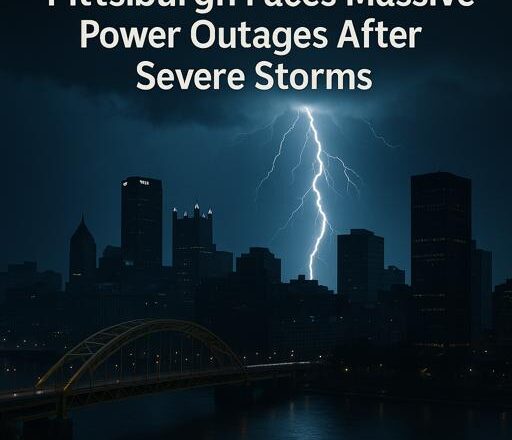pittsburgh power outages severe storms: On April 29, 2025, Pittsburgh endured one of the most powerful storm systems in recent history, leaving over 200,000 homes and businesses without electricity. The destructive winds, torrential rainfall, and widespread damage caused significant disruption across the city, forcing residents, utility providers, and local authorities to respond rapidly.
Pittsburgh Faces Massive Power Outages After Severe Storms
A City Battling Nature’s Wrath
The storm brought wind speeds exceeding 70 miles per hour, wreaking havoc on neighborhoods in Allegheny and Beaver counties. Trees were uprooted, utility poles snapped, and buildings suffered structural damage. Streets turned into obstacle courses as debris scattered everywhere. For some, the storm was deadly. Tragically, two lives were lost, including one incident involving electrocution in Pittsburgh’s South Side Slopes.
Utility companies struggled to cope with the sheer scale of the outages. Duquesne Light Company reported that over 240,000 of its customers were affected, while FirstEnergy experienced tens of thousands of additional outages. The aftermath left residents grappling with disrupted routines, damaged properties, and concerns for safety.
Emergency Response to the Crisis
Local governments and emergency teams acted quickly to address the situation. Officials declared states of emergency in heavily impacted areas, like the Forest Hills borough, to streamline relief efforts. Duquesne Light and FirstEnergy deployed crews across the city, working under challenging conditions to restore power. However, the extensive damage delayed progress, leaving some areas without electricity longer than anticipated.
Residents were urged to stay indoors, avoid downed power lines, and report dangerous situations immediately. These precautionary measures helped prevent further injuries and accidents during the cleanup and recovery process.
Utility Companies Take Proactive Steps
Recognizing the increasing frequency of such severe weather events, utility companies are stepping up their efforts to fortify infrastructure. Duquesne Light has ramped up vegetation management around power lines and reinforced weak points in its electrical grid. Advanced monitoring systems are being introduced to detect issues early and address them swiftly.
Meanwhile, FirstEnergy is exploring long-term investments, such as underground power line installations and smart grid technology, to enhance reliability during extreme weather. These initiatives reflect a shift toward sustainable and resilient energy solutions that aim to protect customers from prolonged outages.
Read also: Thomas Partey Arsenal Career, Transfers, Controversies & More
Vulnerable Communities Hit Hard
For Pittsburgh’s most vulnerable residents, the storm’s impact was especially severe. Elderly individuals, low-income families, and those relying on medical equipment faced heightened risks during the outages. Access to essential services, including heating, cooling, and medical care, was abruptly cut off.
Community organizations stepped in to provide critical support. Emergency shelters opened their doors, volunteers distributed food and water, and neighbors worked together to help those in need. The resilience and generosity shown by Pittsburgh’s residents underscored the strength of the city in times of crisis.
Climate Change and Its Role in Extreme Weather
Meteorologists and environmental experts are linking the growing intensity of storms like this to climate change. Rising global temperatures are fueling more extreme weather patterns, with stronger winds and heavier rainfall becoming increasingly common.
For Pittsburgh, this means it’s time to take proactive steps toward climate resilience. Local initiatives, including stormwater management systems and green infrastructure projects, could help reduce vulnerabilities during future storms. Transitioning to renewable energy sources and lowering carbon emissions are also key strategies for addressing the root causes of climate change.
Staying Prepared for What’s Ahead
This storm serves as a wake-up call for residents to be better prepared for emergencies. Building a storm readiness kit with essentials like food, water, flashlights, and first-aid supplies can make a significant difference during outages. Staying informed through weather updates and developing a clear emergency plan can help residents stay safe in challenging conditions.
Local Authorities Plan for the Future
Pittsburgh’s government officials are already taking action to prevent similar disruptions in the future. By activating emergency protocols during the crisis, they ensured swift mobilization of resources. Moving forward, authorities are evaluating infrastructure policies to identify weaknesses and secure funding for disaster prevention projects. Collaboration with utility companies remains a priority, as does engaging the community to enhance overall preparedness.
These forward-thinking measures reflect Pittsburgh’s determination to build a more resilient city, capable of weathering the challenges posed by an unpredictable climate.
For more details about the ongoing recovery efforts and updates on power restoration, visit the Duquesne Light Outage Map or check the latest information on WTAE’s storm coverage.
